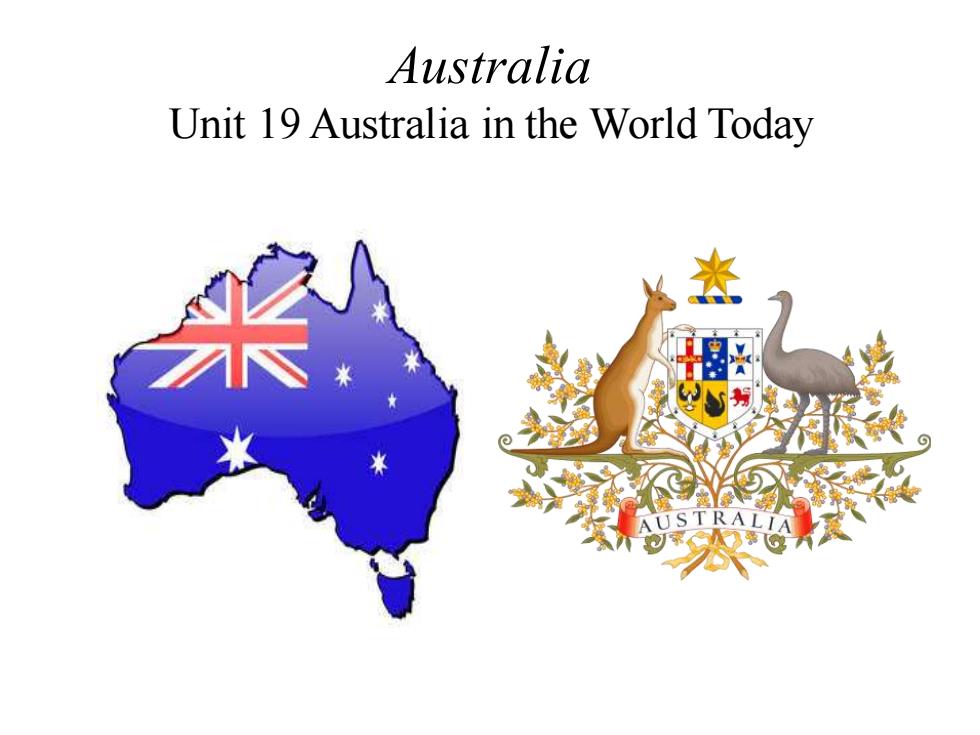
Australia Unit 19 Australia in the World Today
Australia Unit 19 Australia in the World Today

Quiz Give the English and a brief explanation for the following: 1全球化 2资本流动 3反恐 4温室气体 5气候变化
Quiz Give the English and a brief explanation for the following: 1 全球化 2 资本流动 3 反恐 4 温室气体 5气候变化
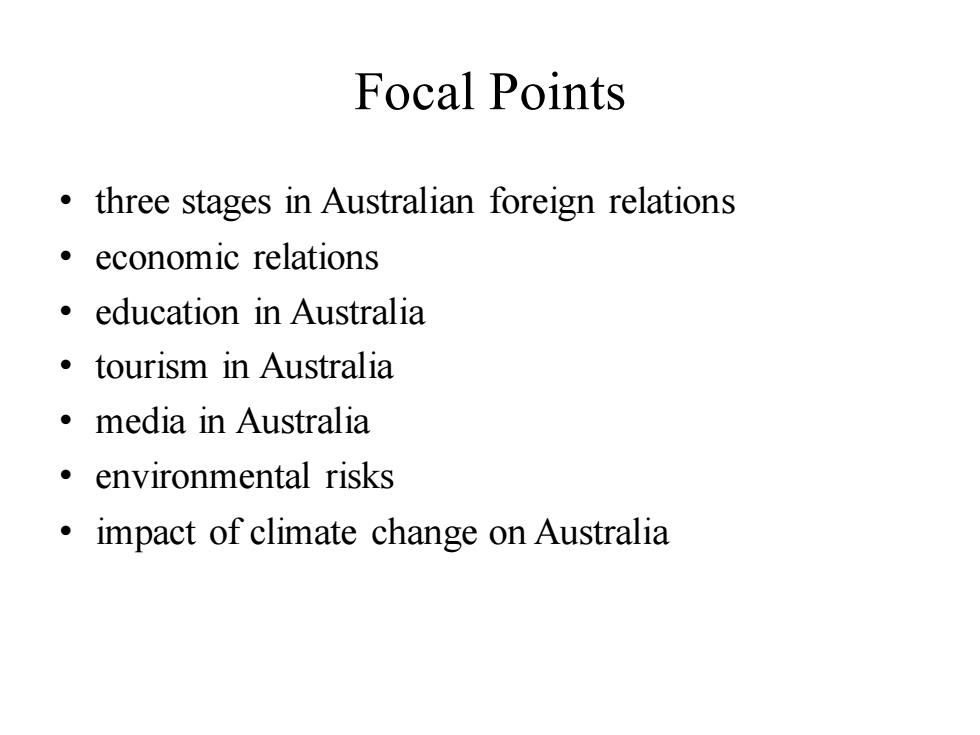
Focal Points three stages in australian foreign relations 。economic relations education in Australia ·tourism in Australia 。media in Australia 。environmental risks impact of climate change on Australia
Focal Points • three stages in Australian foreign relations • economic relations • education in Australia • tourism in Australia • media in Australia • environmental risks • impact of climate change on Australia

This Unit Is Divided into Six Sections I.Australia:Foreign Relations II.Economic Relations III.Education:Global Flows of Capital and People IV.Tourism in Australia:Global Flows of Capital, People and Culture V.The Australian Media:Flows of Capital,Culture and Technology VI.Globalisation and Environmental Risks:Flows of Pollution
This Unit Is Divided into Six Sections I. Australia: Foreign Relations II. Economic Relations III. Education: Global Flows of Capital and People IV. Tourism in Australia: Global Flows of Capital, People and Culture V. The Australian Media: Flows of Capital, Culture and Technology VI. Globalisation and Environmental Risks: Flows of Pollution
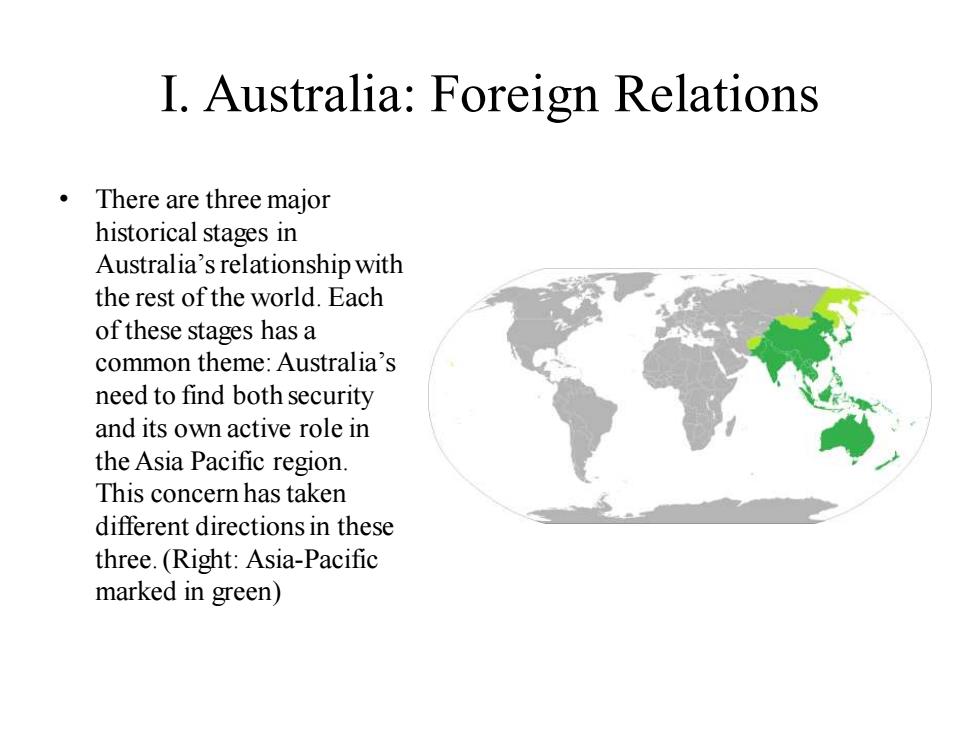
I.Australia:Foreign Relations ·There are three major historical stages in Australia's relationship with the rest of the world.Each of these stages has a common theme:Australia's need to find both security and its own active role in the Asia Pacific region. This concern has taken different directions in these three.(Right:Asia-Pacific marked in green)
I. Australia: Foreign Relations • There are three major historical stages in Australia’s relationship with the rest of the world. Each of these stages has a common theme: Australia’s need to find both security and its own active role in the Asia Pacific region. This concern has taken different directions in these three. (Right: Asia-Pacific marked in green)
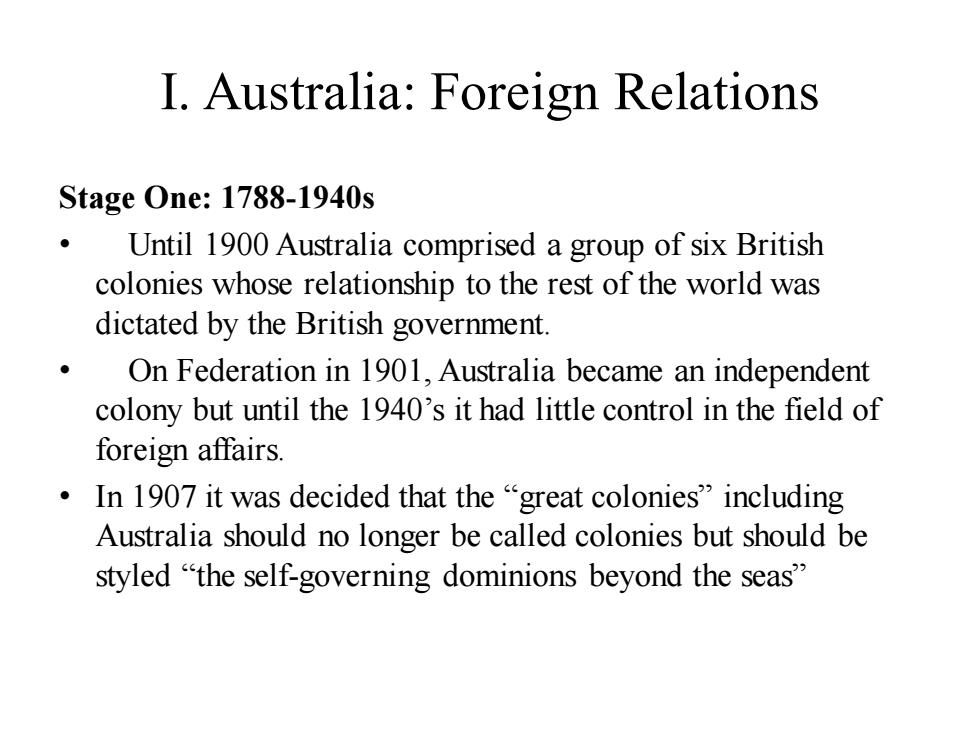
I.Australia:Foreign Relations Stage One:1788-1940s Until 1900 Australia comprised a group of six British colonies whose relationship to the rest of the world was dictated by the British government. On Federation in 1901,Australia became an independent colony but until the 1940's it had little control in the field of foreign affairs. In 1907 it was decided that the "great colonies"including Australia should no longer be called colonies but should be styled "the self-governing dominions beyond the seas
I. Australia: Foreign Relations Stage One: 1788-1940s • Until 1900 Australia comprised a group of six British colonies whose relationship to the rest of the world was dictated by the British government. • On Federation in 1901, Australia became an independent colony but until the 1940’s it had little control in the field of foreign affairs. • In 1907 it was decided that the “great colonies” including Australia should no longer be called colonies but should be styled “the self-governing dominions beyond the seas
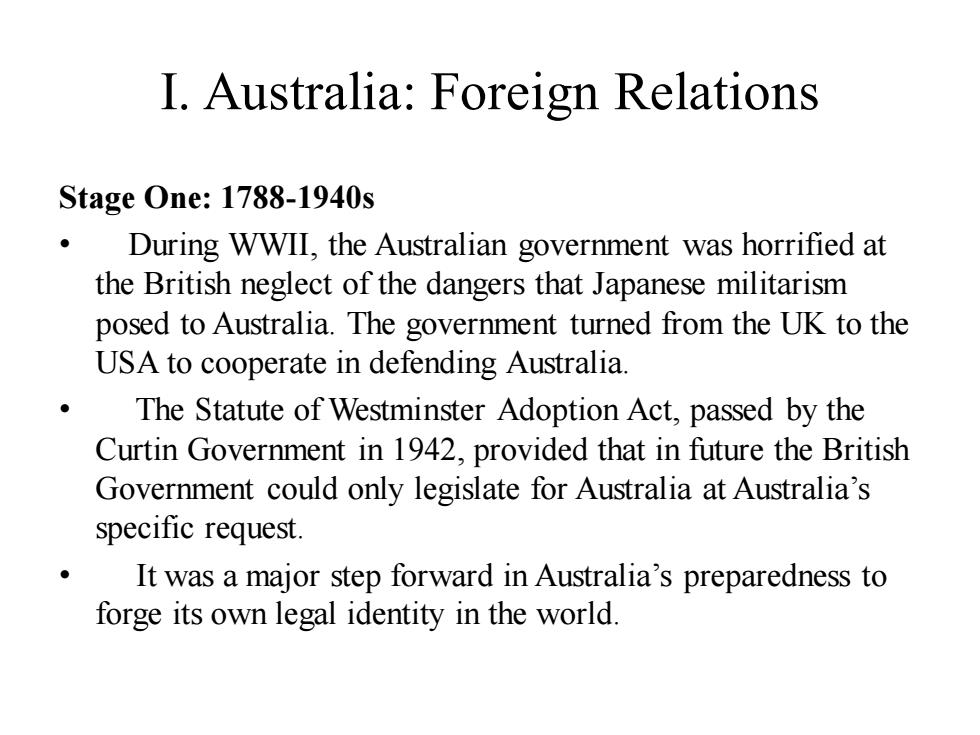
I.Australia:Foreign Relations Stage One:1788-1940s During WWII,the Australian government was horrified at the British neglect of the dangers that Japanese militarism posed to Australia.The government turned from the UK to the USA to cooperate in defending Australia. The Statute of Westminster Adoption Act,passed by the Curtin Government in 1942,provided that in future the British Government could only legislate for Australia at Australia's specific request. It was a major step forward in Australia's preparedness to forge its own legal identity in the world
I. Australia: Foreign Relations Stage One: 1788-1940s • During WWII, the Australian government was horrified at the British neglect of the dangers that Japanese militarism posed to Australia. The government turned from the UK to the USA to cooperate in defending Australia. • The Statute of Westminster Adoption Act, passed by the Curtin Government in 1942, provided that in future the British Government could only legislate for Australia at Australia’s specific request. • It was a major step forward in Australia’s preparedness to forge its own legal identity in the world
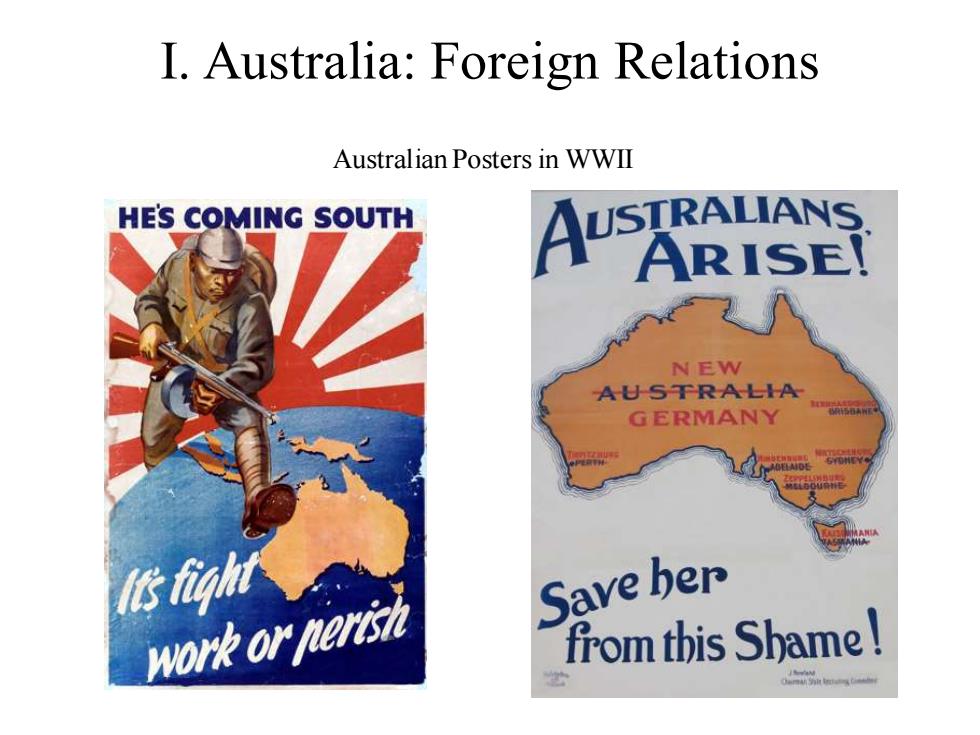
I.Australia:Foreign Relations Australian Posters in WWII HES COMING SOUTH A5as登置 NEW AUSTRALIA GERMANY Bo价 ow次agt Save ber from this Shame!
I. Australia: Foreign Relations Australian Posters in WWII

I.Australia:Foreign Relations Stage Two:1940s -1970s The danger during this period was that Australia had simply exchanged domination by the UK for domination by the USA The post-war successes of communism in Russia and China bred paranoia in the West.Australia was positioned as the "West's outpost"in the Asia Pacific. The ANZUS treaty was signed by Australia,New Zealand and the United States in 1951.From the 1950s to the 1970s Australia became involved in the American "crusade against communism"in the Korean War and the Vietnam War. Meanwhile,the unpopular policy of conscription-by-ballot became one of the major factors leading to a negative reaction to Australia's relationship with the USA
I. Australia: Foreign Relations Stage Two: 1940s -1970s • The danger during this period was that Australia had simply exchanged domination by the UK for domination by the USA. • The post-war successes of communism in Russia and China bred paranoia in the West. Australia was positioned as the “West’s outpost” in the Asia Pacific. • The ANZUS treaty was signed by Australia, New Zealand and the United States in 1951. From the 1950s to the 1970s Australia became involved in the American “crusade against communism” in the Korean War and the Vietnam War. • Meanwhile, the unpopular policy of conscription-by-ballot became one of the major factors leading to a negative reaction to Australia’s relationship with the USA
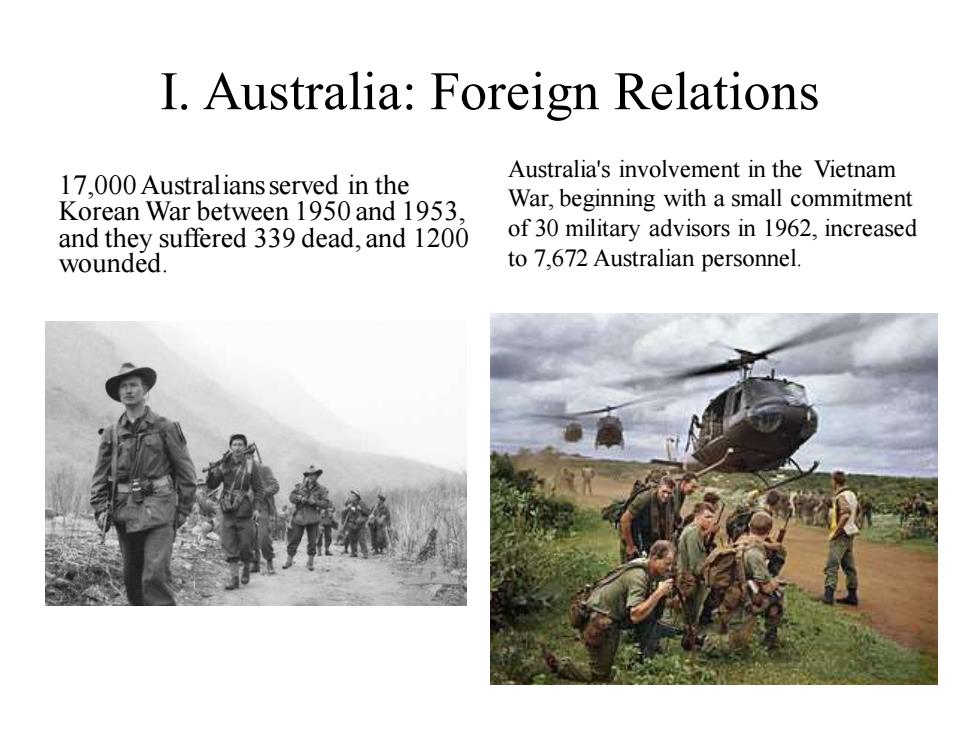
I.Australia:Foreign Relations Australia's involvement in the Vietnam 17.000 Australians served in the Korean War between 1950 and 1953, War,beginning with a small commitment and they suffered 339 dead,and 1200 of 30 military advisors in 1962,increased wounded. to 7,672 Australian personnel
I. Australia: Foreign Relations 17,000 Australians served in the Korean War between 1950 and 1953, and they suffered 339 dead, and 1200 wounded. Australia's involvement in the Vietnam War, beginning with a small commitment of 30 military advisors in 1962, increased to 7,672 Australian personnel